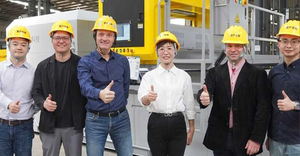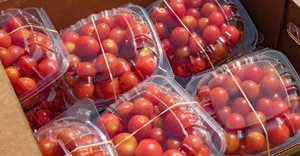Communities find many benefits to building environmentally friendly MRFs and transfer stations
November 1, 2008
Nancy Mann Jackson

Community recycling efforts are vital for creating greener communities. But often, the very facilities where such environmentally friendly work is done are not designed or constructed in an eco-conscious way. While the inconsistency doesn't negate the value of recycling, operating a recycling program in an eco-friendly facility sends a strong message of environmental responsibility and can generate cost-saving benefits in the process.
More communities across the country are determining that green-built materials recovery facilities (MRFs) — as well as transfer stations — are logical facilities to demonstrate their environmental ideals. In Summit County, Colo., for instance, "the community is aware of rising energy prices, limited resources and the need for a state-of-the-art recycling facility, and has an active and vocal population of environmentally sensitive residents," says Carly Wier, executive director of the High Country Conservation Center, which ran the county's recycling program as a nonprofit until the program was taken over by the county government in 2006. Several years ago, "the county commissioners decided that it was time to construct a green facility to test [environmental] concepts within a budget, and the [MRF] facility was the perfect venue for testing the green waters."
Just this year, Phoenix passed a resolution requiring all new city-owned buildings to be built to meet the U.S. Green Building Council's Leadership in Energy and Environmental Design (LEED) standards, says Marty Arambel, manager of the city's North Gateway Transfer Station, which was completed in 2006. "When we planned for this new facility, the policy wasn't in effect, but we knew it was coming," he says. "So we tried to do as much as we could to make the station environmentally responsible. The mayor of our city is focused on sustainability. It's the direction our city is going."
Greening the Facility
There are numerous ways to make a waste facility more environmentally responsible. In Phoenix, the North Gateway Transfer Station incorporated a number of green building aspects, such as using a pre-engineered building, recycled steel and high-emissivity cool roof coatings, which reflect the sun's ultraviolet rays so coolers don't have to work as hard. In response to the facility's naturally hot environment, its metal wall panels were mixed with concrete and perforated to provide additional ventilation," Arambel says. "We extended the walls beyond the building to keep it cooler."
Summit County, Colo.'s MRF, completed in September 2006, often serves as an educational destination for both children and adults learning about waste issues. "So highlighting recycled and re-used materials was very important to the design team," Wier says. The facility partially is built with recycled steel. It also features a salvaged beam from a used building materials center and recycled rubber flooring.
The Shoreline Recycling and Transfer Station in King County, Wash., perhaps the greenest transfer station anywhere, was awarded LEED platinum certification, the highest designation given by the U.S. Green Building Council. Among just 60 projects in the United States to have received such a certification, Shoreline is the only transfer station to achieve the rating. The facility includes a rooftop rainwater harvesting system, solar electricity panels, building components made of recycled content and a number of other environmentally friendly improvements.
Realizing Benefits
Green MRFs and transfer stations can increase efficiencies and decrease operating costs. The Summit County facility includes two energy recovery ventilators that recover heat from outgoing air to warm incoming air. "Of course, air quality is a critical issue in a MRF, so finding a way to keep energy costs low with substantial air exchanges was very important," Wier says.
Summit County also reduced costs by incorporating daylight harvesting into the design. "The lights in industrial facilities like this are those huge halogen bulbs, which use a lot of energy," Wier says. "But with substantial daylighting, even on cloudy days, the staff hardly ever needs to turn them on. That has substantially reduced operating costs."
Along with the financial benefits, greener waste facilities also offer public relations advantages. "We have found that pursuing a higher environmental standard has helped tremendously with community acceptance," says Kevin Kiernan, division director for the King County Solid Waste Division. "[It helps to] begin the process as early as possible and involve the community as much as possible."
New Possibilities
Once a green facility is built and has achieved acceptance from the community, numerous programs can be implemented to further the goals of the facility. For instance, in Montgomery County, Ohio, a green transfer station was completed in 2006. Its additional enclosed space has allowed the county to institute a number of new, safe drop-off and recycling programs. A new hard household plastics recovery program, the only one of its kind in Ohio, allows for the recovery of items such as lawn furniture and toys.
The station also hosts an electronics recovery program. "One day a month we are able to accept electronics from small businesses to be recycled free of charge," says Phil Miller, manager of the engineering and construction division of Montgomery County Public Works. "Since starting this program in October 2006, we have diverted an additional 267 tons of electronics."
"In the future, we will use the additional space to add processing equipment to recover materials from the tipping loor, increasing our recycling rate and diversion goals to be a leader statewide," Miller says.
Even after construction is complete, facilities can continue to add new components that will complement their environmental priorities. For instance, Montgomery County installed a fueling station adjacent to the transfer station that includes a tank for alternative fuels such as bio-diesel. While the original budget in Summit County didn't accommodate on-site renewable energy generation, the county is testing a wind turbine on the facility for power use, Wier says.
Making It Work
If the viability of a "green" waste facility seems doubtful, those who have completed the process say it can be done. "Don't be deterred by the nature of the facility," Wier says. "There are many solutions that can incorporate various shades of green and various budgets too. Just because a facility is industrial in nature doesn't mean you can't have a healthy indoor environment and some energy saving features as well."
Arambel recommends including both the builder and the designer in the process from the beginning. "Usually, the process is design, bid, build," he says. "But we got the design team and the construction team in place [first] so they worked together from the beginning.
"If you have a design engineer who understands LEED design and a builder who can build it [to LEED specifications], a lot of good ideas will come out of that partnership," Arambel says.
Finally, study what's been done before and what's working well for neighboring cities and others across the country. "Municipalities provide leadership through their facilities and business practices," Miller says. "Care should always be given to researching life cycle cost benefits and learning from best practices. Don't reinvent the wheel. Research and see where the wheel is turning most efficiently and creatively."
Nancy Jackson is a contributing writer based in Florence, Ala.
You May Also Like


